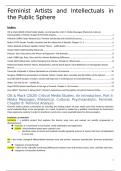Feminist Artists and Intellectuals in
the Public Sphere
Index
Ott & Mack (2020) Critical Media Studies. An Introduction. Part II: Media Messages; Rhetorical, Cultural,
Psychoanalytic, Feminist. Chapter 8: Feminist Analysis...................................................................................................1
Mohanty (1984) Under Western Eyes. Feminist Scholarship and Colonial Discourses.....................................................4
Butler (1999) Gender Trouble: Feminism and the Subversion of Identity. Chapter 2 + 5..................................................6
Video: Berkeley professor explains Gender Theory – Judith Butler..................................................................................7
Hooks (2022) Understanding Patriarchy..........................................................................................................................7
Podcast: Toxic Masculinity with Mayor of Kingstown’s Tobi Bamtefa..............................................................................8
Lorde (1980) Age, Race, Class and Sex: Women Redefining Difference...........................................................................8
Campt (2021) Black Gaze: Artists Changing How We See. Prelude to a Black Gaze.........................................................8
Mahmood (2001) Feminist Theory, Embodiment, and the Docile Agent: Some Reflections on the Egyptian Islamic
Revival............................................................................................................................................................................. 9
Transcript of Episode 3: African Spirituality as a Practice of Feminism..........................................................................10
Sturgeon (2008) Environmentalism in Popular Culture: Gender, Race, Sexuality and the Politics of the Natural...........11
Scuriatti (2007) Designer’s bodies: women and body hair in contemporary art and advertising...................................12
Video: Can hair be art? - Laetitia Ky...............................................................................................................................13
Angel (2022) Women and Desire in the Age of Consent. Chapter 1: On Consent..........................................................13
Jane (2021) ‘Feminism is Eating Itself’: Women’s Experiences and Perceptions of Lateral Violence Online...................14
Ott & Mack (2020) Critical Media Studies. An Introduction. Part II:
Media Messages; Rhetorical, Cultural, Psychoanalytic, Feminist.
Chapter 8: Feminist Analysis
Feminist media scholars concentrate on revealing the limiting nature of mass media texts that reinforce dominant
social understandings of sex and gender. As a result, feminism is marked by a political commitment to deconstruct
these oppressive systems in order to transform society into a more equitable place for diverse peoples.
Feminism: an overview
Feminism = a political project that explores the diverse ways men and women are socially empowered or
disempowered.
Feminism is a movement to end sexism, sexist exploitation and oppression.
Sexism = discrimination based upon a person’s sex.
o Feminism seeks to reveal and eradicate socially ingrained systems of sexism that harm all individuals
in some way.
Sex = the innate, biological differentiation between men and women: anatomy, reproduction, hormone production,
etc.
Categories of male/female
Gender = refers to the culturally constructed differences between men and women: tastes, roles, activities and more.
Categories of masculine/feminine
1
, Essentialism = the belief that gender distinctions are innate and natural where culturally constructed norms are seen
as innate biological traits.
Patriarchy = a system of power relations in which women’s interests are subordinated to those of men. Patriarchy
essentializes women in a way that devalues them while predominantly serving the interests of men.
Patriarchal systems empower men and disempower women by making constructed, gendered power
imbalances seem natural and innate.
Everyone is sexist, as everyone plays along in the game that is called society. That our society is patriarchal
makes everyone sexist as everyone plays by the rules of society. When people (attempt to) reject the rules of
the patriarchal society they are called feminists.
Not only women are harmed by the patriarchal society, as this society has gendered expectations that
include why men show little emotion, avoid certain occupations or act as the breadwinner of their families.
Stereotyping in American media
Stereotype = a misleading and simplified representation of a particular social group.
Stereotypes are damaging as they gloss over the complex characteristics that actually define a group and
reduces its members to a few (usually unfavorable) traits. When these stereotypical representations become
commonly accepted in the media, the result is often the social oppression and disempowerment of
individuals within the stereotyped group.
Socially powerful groups (like men) have greater access to media outlets as a function of privilege, and this access
grants them the ability to represent their particular impressions of other social groups to the widest audiences.
These perspectives are often stereotypically reductionist, but they become the most widely known and accepted
representations of these social groups.
How do other qualities of stereotypes contribute to the presence of stereotypes in the media?
1. Everyone stereotypes. Stereotyping helps individuals make sense of an increasingly complex
contemporary society. Stereotypes (or mental categories) allow individuals to quickly process incoming
information about strangers by greatly reducing the amount of information to absorb.
2. For such simplistic reductions of character, widespread social stereotypes are actually rather intricate in
their construction. Stereotypes often blend realistic aspects of life, material conditions and social roles
into inaccurate assumptions and false traits. Stereotypes persist in the media because they have enough
truth to sound plausible without much critical thought.
3. Sometimes members of socially oppressed groups will believe the stereotypes that they see in the media
to be true and emulate them (self-fulfilling prophecy).
4. Media images that feature stereotypes gain an informal credibility because they match some of the
common stereotypes people use every day to reduce information processing.
Gendered stereotypes in American media
In general, masculine stereotypes are defined by power, significance, agency and social influence. Stereotypes of
femininity are defined by powerlessness, insignificance, passiveness and limited control. These stereotypes reinforce
patriarchal systems of power by supporting the domination of men over women.
Active/passive
Mainstream media representations of men and masculinity are often marked by strength and activity.
Eg. men engaging in sports, working with tools, driving big vehicles, etc.
Images of women tend to emphasize passiveness and weakness.
Eg. standing/sitting beautifully to advertise their product, etc.
This general contrast between men and women in advertising is striking and the repetition of this motif across many
different kinds of ads makes the distinction seem normal. ‘Being a man’ is being defined by being active, while
femininity seems to be defined by helplessness and passive acceptance.
Public/private
Popular American television shows often draw sharp distinctions between men and women in relation to public and
private spheres. Because men are represented as active and strong, they also tend to fulfill the role of ‘family
2




